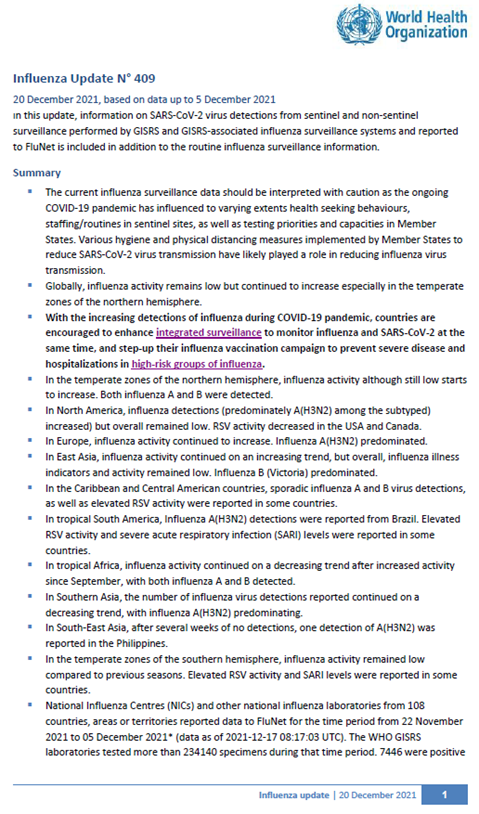Influenza Update N° 409

Overview
20 December 2021, based on data up to 5 December 2021
Information in this report is categorized by influenza transmission zones, which are geographical groups of countries, areas or territories with similar influenza transmission patterns. For more information on influenza transmission zones, see the link below:
Influenza Transmission Zones (pdf, 659kb)
- The current influenza surveillance data should be interpreted with caution as the ongoing COVID-19 pandemic has influenced to varying extents health seeking behaviours, staffing/routines in sentinel sites, as well as testing priorities and capacities in Member States. Various hygiene and physical distancing measures implemented by Member States to reduce SARS-CoV-2 virus transmission have likely played a role in reducing influenza virus transmission.
- Globally, influenza activity remains low but continued to increase especially in the temperate zones of the northern hemisphere.
- With the increasing detections of influenza during COVID-19 pandemic, countries are encouraged to enhance integrated surveillance to monitor influenza and SARS-CoV-2 at the same time, and step-up their influenza vaccination campaign to prevent severe disease and hospitalizations in high-risk groups of influenza.
- In the temperate zones of the northern hemisphere, influenza activity although still low starts to increase. Both influenza A and B were detected.
- In North America, influenza detections (predominately A(H3N2) among the subtyped) increased) but overall remained low. RSV activity decreased in the USA and Canada.
- In Europe, influenza activity continued to increase. Influenza A(H3N2) predominated.
- In East Asia, influenza activity continued on an increasing trend, but overall, influenza illness indicators and activity remained low. Influenza B (Victoria) predominated.
- In the Caribbean and Central American countries, sporadic influenza A and B virus detections, as well as elevated RSV activity were reported in some countries.
- In tropical South America, Influenza A(H3N2) detections were reported from Brazil. Elevated RSV activity and severe acute respiratory infection (SARI) levels were reported in some countries.
- In tropical Africa, influenza activity continued on a decreasing trend after increased activity since September, with both influenza A and B detected.
- In Southern Asia, the number of influenza virus detections reported continued on a decreasing trend, with influenza A(H3N2) predominating.
- In South-East Asia, after several weeks of no detections, one detection of A(H3N2) was reported in the Philippines.
- In the temperate zones of the southern hemisphere, influenza activity remained low compared to previous seasons. Elevated RSV activity and SARI levels were reported in some countries.
- In South-East Asia, no new influenza detections were reported.
- In the temperate zones of the southern hemisphere, influenza activity remained low in Oceania and temperate South America but was increased in South Africa. RSV activity remained elevated in some countries.
- National Influenza Centres (NICs) and other national influenza laboratories from 108 countries, areas or territories reported data to FluNet for the time period from 22 November 2021 to 05 December 2021* (data as of 2021-12-17 08:17:03 UTC). The WHO GISRS laboratories tested more than 234140 specimens during that time period. 7446 were positive for influenza viruses, of which 4327 (58.1%) were typed as influenza A and 3119 (41.9%) as influenza B. Of the sub-typed influenza A viruses, 276 (9.9%) were influenza A(H1N1)pdm09 and 2520 (90.1%) were influenza A(H3N2). Of the characterized B viruses, 0 (0%) belonged to the B-Yamagata lineage and 2738 (100%) to the B-Victoria lineage.

During the COVID-19 pandemic, WHO encourages countries, especially those that have received the multiplex influenza and SARS-CoV-2 reagent kits from GISRS, to continue routine influenza surveillance, test samples from influenza surveillance sites for influenza and SARS-CoV-2 viruses where resources are available and report epidemiological and laboratory information in a timely manner to established regional and global platforms (see the guidance here: https://apps.who.int/iris/rest/bitstreams/1316069/retrieve).
- At the global level, SARS-CoV-2 percent positivity from sentinel surveillance continued to decrease and was under 10%. Activity remained under 10% positivity for all regions except the European Region of WHO, where an increasing trend in positivity was observed. Overall positivity from non-sentinel sites continued to decrease, remaining just under 7%. However, among the WHO South-East Asian region non-sentinel sites, positivity continued to increase to almost 35%.
- National Influenza Centres (NICs) and other national influenza laboratories from 47 countries, areas or territories reported data to FluNet for the time period from six WHO regions (African Region: 1; Region of the Americas: 13; Eastern Mediterranean Region: 4; European Region: 21; South-East Asia Region: 4; Western Pacific Region: 4 ) reported to FluNet from sentinel surveillance sites for time period from 22 Nov 2021 to 05 Dec 2021* (data as of 2021-12-17 08:17:03 UTC). The WHO GISRS laboratories tested more than 54 184 sentinel specimens during that time period and 7908 (14.6%) were positive for SARS-CoV-2. Additionally, more than 1171445 non-sentinel or undefined reporting source samples were tested in the same period and 89 199 were positive for SARS-CoV-2. Further details are included at the end of this update.
Source of data
______________________________________________________________________________________________
The Global Influenza Programme monitors influenza activity worldwide and publishes an update every two weeks. The updates are based on available epidemiological and virological data sources, including FluNet (reported by the WHO Global Influenza Surveillance and Response System), FluID (epidemiological data reported by national focal points) and influenza reports from WHO Regional Offices and Member States. Completeness can vary among updates due to availability and quality of data available at the time when the update is developed.
*It includes data only from countries reporting on positive and negative influenza specimens.
